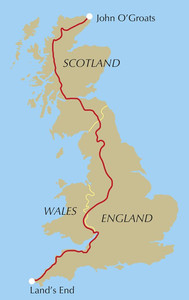How do you prepare for cycling from Land's End to John O'Groats?
- panlitoure
- Feb 22, 2020
- 3 min read
Updated: Dec 7, 2021
While some people taking on Land’s End to John O’ Groats will have years of long-distance cycling under their belt, and months of training in the run up to the event, others like my client Stuart have taken up cycling only this year.
Land’s End to John O’Groats is an iconic long-distance ride. It spans the length of mainland UK from the gorgeous beaches of Cornwall to the stunning countryside of northern Scotland.
Stuart came to me in December and said “I’m going for LeJoG this year”. I had no clue what it was. Is a cycle ride of 14 days covering 1600 km (115 km a day) and he wants to do it in September 2020.
You can all imagine the fitness level needed to take on a challenge like that.
“Ok!” I said “lets set a Training Plan—But let’s Make It Fun”.
Stuart run the marathon last year, and he has been training with me for over four years. After years of holistic training we achieved the physical, emotional, mental high level of fitness performance that we aimed at, and Mr Stu is in a good shape. He has done many of the following.
High intensity interval training, or HIIT- intense bursts of exercise with recovery periods between that is great for endurance events. Evidence shows that it can bring about some of the same physiological adaptations as endurance training, only in less time.
My zone heart rate monitor is an innovative wearable heart rate-based system that uses wireless and cloud technology to accurately and conveniently monitor physical activity. Is very useful to monitor the level of fitness.
The point of training, of course, is to get your mind and body used to a certain amount of effort, to make that effort easier, and work out your own fuelling strategy. Proper nutrition is key to big miles, both on and off the bike.
Your body becomes a “furnace”, and as you can only absorb so many calories per hour, therefore it is important to stay on top of the fuelling of your body, therefore you need to increase your carbs intake. Every morning eat an early pre-ride breakfast.
You need to aim to drink about one bottle of water per hour, depending on heat and exertion level.
For recovery, I recommend pea protein and magnesium powder to prevent muscle cramping. Pea protein helps to provide both, a pre-workout energy boost and improved post-workout muscle recovery. It has a complete array of amino acids, including high levels of branched-chain amino acids (BCAAs).
While its amino acid profile is like whey protein, pea protein is particularly high in arginine, lysine, and phenylalanine. Its well-balanced profile fulfils the essential amino acid requirements outlined by the World Health Organization for adults.
While magnesium most important job is to regulate muscle function throughout the body, including the heart muscle, magnesium also helps the heart to maintain a healthy rhythm.
Use this simple reminder about what makes you fitter: A B C: A for Aerobic - riding four to six hours a week; B for Breakfast-less rides for up to two hours to make your body fat-burning savvy, and C for Consistency.
The right pair of shoes is also very important – mould of the foot setup with supportive insoles.
You must check your position. Ensure your bike is set up correctly for your body with the saddle in the correct place before you get started. Try to use each leg equally- you should be aiming for a 50/50 split across both legs. Pedal Smart!!
These apparently small tweaks can result in a 10% improvement in power output. Aches and pains crop up during long rides. To minimize them, move.
• Periodically change hand positions, keeping your thumbs wrapped around the bar or brake lever for security.
• To relieve your neck and shoulders, shrug for 5 to 10 seconds.
• On a clear stretch of road, reach one hand up between your shoulders for a few seconds, then swap hands.
• Stand up and drop one pedal so your leg is straight. Let your heel sag below the pedal. Hold for 20 seconds, then switch legs.
Cyclists, especially those training regularly, may be renowned for their supreme cardiovascular fitness, phenomenal power output and colossal thighs, but when it comes to flexibility, it must be said that most are decidedly lacking.
it’s not surprising when you consider what riding a bike entail. It’s a repetitive action performed through a limited range of motion, which means that the legs are neither fully extended nor fully flexed.
If muscles get tight, they pull on bones and put things out of alignment, increasing the risk of pain, discomfort and injury. Therefore dynamic’ stretching in your warm-up will prepare your muscles. Take your joints through movements that replicate the range of motion you’ll be using.
After a ride, use static stretching to help restore muscles to their ‘resting’ length, or to develop length in shortened muscles. Massages and Yoga or Pilates are also recommended to avoid injury.






Comments